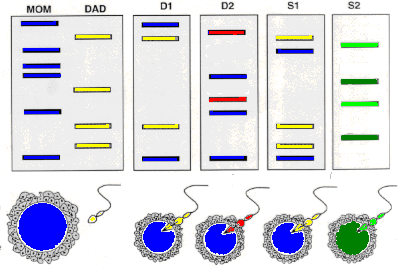
Every strand of DNA has pieces that contain genetic information which informs an organism's development (exons) and pieces that, apparently, supply no relevant genetic information at all (introns). Although the introns may seem useless, it has been found that they contain repeated sequences of base pairs. These sequences, called Variable Number Tandem Repeats (VNTRs), can contain anywhere from twenty to one hundred base pairs.
Every human being has some VNTRs. To determine if a person has a particular VNTR, a Southern Blot is performed, and then the Southern Blot is probed, through a hybridization reaction, with a radioactive version of the VNTR in question. The pattern which results from this process is what is often referred to as a DNA fingerprint.
A given person's VNTRs come from the genetic information donated by his or her parents; he or she could have VNTRs inherited from his or her mother or father, or a combination, but never a VNTR either of his or her parents do not have. Shown below are the VNTR patterns for Mrs. Nguyen [blue], Mr. Nguyen [yellow], and their four children: D1 (the Nguyens' biological daughter), D2 (Mr. Nguyen's step-daughter, child of Mrs. Nguyen and her former husband [red]), S1 (the Nguyens' biological son), and S2 (the Nguyens' adopted son, not biologically related [his parents are light and dark green]).

Because VNTR patterns are inherited genetically, a given person's VNTR pattern is more or less unique. The more VNTR probes used to analyze a person's VNTR pattern, the more distinctive and individualized that pattern, or DNA fingerprint, will be.
![]() NEXT TOPIC:
Applications of DNA Fingerprinting
NEXT TOPIC:
Applications of DNA Fingerprinting